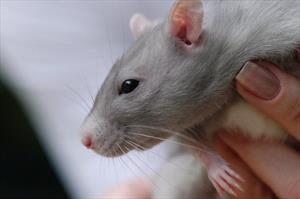Rat in woman's hand

Photo courtesy of Depositphotos
When I talk to veterinary and public health audiences about zoonotic diseases, I often talk about rat bite fever because it highlights some common issues that are important to keep in mind.
Usually, I start by presenting a case of a child with a fever and rash.
Then, I mention that someone finally asked about pets and they reported a rat bite.
Then, I say “what does the kid probably have?”
- And I get… blank stares 95% of the time.
Then I say “the kid had a rat bite and has a fever… what is it?”
- More blank stares (some are probably asleep, admittedly).
Then I say “rat bite fever [pause]… seriously, that’s the name of the disease.”
- Still some blank stares (and the odd snore).
Beyond showing the limited awareness of this disease, the cases in which I get involved have a few common themes:
- The bite is rarely reported initially. It’s not usually until the person gets referred to a specialist that someone asks about pet contact. “Has your child had any animal contact?” is an easy question to ask, but it rarely gets asked, in my experience. So, the opportunity for early diagnosis is missed.
- The important issue of zoonotic disease risk and risk acceptance that go along with pet ownership or animal contact. Pretty much all rats harbour the bacterium that causes rat bite fever (Streptobacillus moniliformis), so every rat poses some degree of risk. The risk can be lowered with good handling practices (to avoid bites) and proper bite first aid. Rat ownership can still be relatively low risk with some common sense, but it’s never zero. People handling or owning rats need to be aware of the risk and how to mitigate it.
Anyway, that’s a long lead-in to a recent paper on rat bite fever in Canada (Hryciw et al, Can Commun Dis Rep 2018).
It’s a recap of 11 cases on Vancouver Island between 2010 and 2016.
- All affected people had pretty typical disease: fever and one or more of muscle pain, rash, joint pain, swollen joints or vomiting.
- Everyone recovered, but seven patients were hospitalized.
- Both bites and scratches were implicated as the source. Scratches are a potential source if they become inoculated with rat saliva at the same time.
- All reported rat contacts were from pet rats.
- Not much more about the rats or bites was reported.
There wasn’t too much remarkable in the paper overall, but it’s another good reminder about this disease and the need to report (patients) and query (healthcare providers) history of pet contact when someone is sick.
More information about rat bite fever can be found on the Worms & Germs Resources – Pets page.
Reprinted with permission from Worms and Germs Blog
1 Comment
David South
May 28, 2019